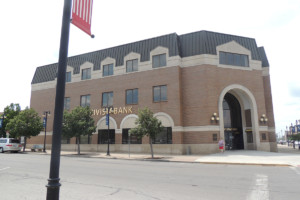
THE STEAMBOAT HOTEL, COLT’S EXCHANGE HOTEL & CIVISTA BANK
In the fall of 1817 before the City of Sandusky was laid out, Cyrus W. Marsh built a frame house near the corner of Wayne and East Water Street where the Civista Bank now stands.
Civista Bank, formerly known as Citizens Bank until 2015, was founded in Sandusky in 1884 and was located in the Feick Building from 1924 until it moved to its current location. It is the only bank headquartered in Sandusky and is currently the 18th largest bank in the State.
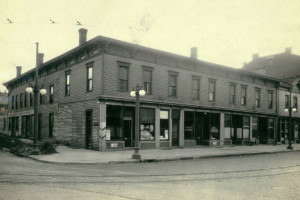
THE STEAMBOAT HOTEL
In 1818 Marsh extended his house to the corner and established the Steamboat Hotel named after the Walk in the Water, the first steamboat on the Great Lakes.
Colt’s Steamboat Hotel, ca. 1900-1920. Image courtesy of Sandusky Library Archives Research Center
In 1820 the first runaway slave recorded as having reached Sandusky was placed in the care of the black caretaker of the stable in the rear of Marsh’s Steamboat Hotel. Despite the offer of a $300.00 reward, no one revealed the slave’s presence and when his owner left for Canada on the Walk in the Water to continue his search, a hotel guest took the runaway to Canada and freedom on his small sailboat.
Cyrus Marsh ran the first stagecoach line from his hotel in 1822. The coach left Sandusky on Mondays and reached Mansfield on Tuesdays and Delaware on Wednesdays. In 1825 Marsh carried Mail by horseback on a weekly route to Lower Sandusky.
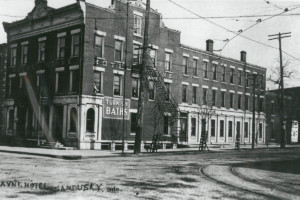 COLT’S EXCHANGE HOTEL
COLT’S EXCHANGE HOTEL
Exchange Hotel, ca. 1840-1860. Image courtesy of Barbara Wendt
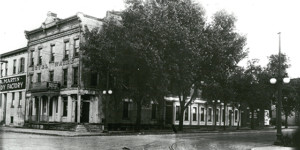
The Civista Bank parking lot at the Southeast corner of East Water Street and Wayne Street was the location of Colt’s Exchange Hotel where Charles Dickens stayed when he visited Sandusky in 1842. The hotel was used as a hospital for cholera victims in the epidemic of 1849.
April 1842 – CHARLES DICKENS VISITS SANDUSKY
In April 1842, the notable English author Charles Dickens was touring the States and visited Sandusky City, traveling from Tiffin on the Mad River Railroad Line. The Conductor, named Higbee, described Dickens as “a pleasant appearing, roast beef eating Englishman.” Dickens wrote about this portion of the trip and described the thriving metropolis of Sandusky at the time that Kelley’s Island was trying to unite with Erie County.
“At 2 o’clock we took the railroad; the traveling on which was very slow, its construction being indifferent and the ground wet and marshy; and arrived at Sandusky in time to dine that evening. We put up at a comfortable little hotel on the brink of Lake Erie, lay there that night, and had no choice but to wait there next day, until a steamboat bound for Buffalo appeared. The town, which was sluggish and uninteresting enough, was something like the back of an English watering-place, out of the season.” This was obviously not well received by the very cosmopolitan people of Sandusky. On the other hand, April is that in-between month after the close of winter when navigation was just opening, and before the ‘tourist season’ would begin. Dickens was correct, Sandusky was definitely ‘out of season.’
Dickens described his stay in very gracious terms – sort of. “Our host, who was very attentive and anxious to make us comfortable, was a handsome middle-aged man, who had come to this town from New England, in which part of the country he was ‘raised.’ When I say he constantly walked in and out of the room with his hat on; and stopped to converse in the same free-and-easy state; and lay down on our sofa, and pulled his newspaper out of his pocket, and read it at his ease; I merely mention these traits as characteristic of the country; not at all as being a matter of complaint, or as having been disagreeable to me. I should undoubtedly be offended by such proceedings at home, because they are not the custom, and where they are not, they would be impertinences. But in America, the only desire of a good-natured fellow of this kind, is to treat his guests hospitably and well; and I had no more right, and I can truly say no more disposition, to measure his conduct by our English rule and standard, then I had to quarrel with him for not being the exact stature which would qualify him for admission into the Queen’s Grenadier Guards.
As little inclination had I to find fault with a funny old lady who was an upper domestic in this establishment, and who, when she came to wait upon us at any meal, sat herself down comfortably in the most convenient chair, and producing a large pin to pick her teeth with, remained performing that ceremony, and steadfastly regarding us meanwhile with much gravity and composure (now and then pressing us to eat a little more), until it was time to clear away. It was enough for us, that whatever we wish done was done with great civility and readiness, and a desire to oblige, not only here, but everywhere else; and that all our wants were, in general, zealously anticipated.”
The Sandusky hotel where he stayed was Colt’s Exchange, later the Wayne Hotel at the southwest corner of Wayne and Water Streets. William West, proprietor of the West House, said that Dickens accepted an invitation to attend a banquet given by Sanduskians to honor him, but at the proper time, he did not come down himself, but sent his secretary instead. It is also believed that the housekeeper that Dickens described was actually the wife of Col. Colt the owner of the hotel, based on a report in the Sandusky Mirror that credited her as being the chef of the hotel. Dickens continued his trip to Buffalo, stopping at Cleveland, which he described as a pretty town.
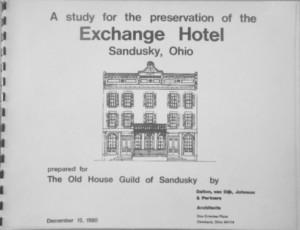 Over the years the hotel has had many names, including the St. Lawrence Hotel, the Porter House, and the Wayne. The building was gutted by fire in 1977 and razed in 1985. An effort was made to save the building in 1980 before it was razed.
Over the years the hotel has had many names, including the St. Lawrence Hotel, the Porter House, and the Wayne. The building was gutted by fire in 1977 and razed in 1985. An effort was made to save the building in 1980 before it was razed.
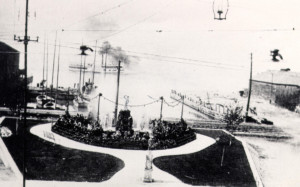
SCOTT’S HOTEL AND BOY WITH THE BOOT
A trivia questions for most people – where was the original home of Sandusky’s beloved Boy with a Boot fountain? It was in a park across from Scott’s European Hotel. Scott purchased the fountain in 1895 and willed it to the City of Sandusky.
Image courtesy of Sandusky Library Archives Research Center
In 1865, Voltaire Scott and his father John, bought what had been the Steamboat Hotel and then Raymond’s Hotel and renamed it Scott’s American.
December 8, 1870 – Lake House – First class House, corner Wayne and Water streets, Sandusky, Ohio. J. D. Bourne Proprietor.
The name was changed to The New Lake House and in the 1890’s to Scott’s European. In 1895, Voltaire Scott established a park across from his hotel at the foot of Wayne Street at his own expense. On a pedestal in the middle of the park, Scott placed Sandusky’s beloved landmark, the statue of the “Boy with the Boot” that now stands in Washington Park. Scott willed the park to the City of Sandusky, but it was destroyed in the tornado of 1924 and converted to a parking lot in 1935. The hotel was razed in 1923.
